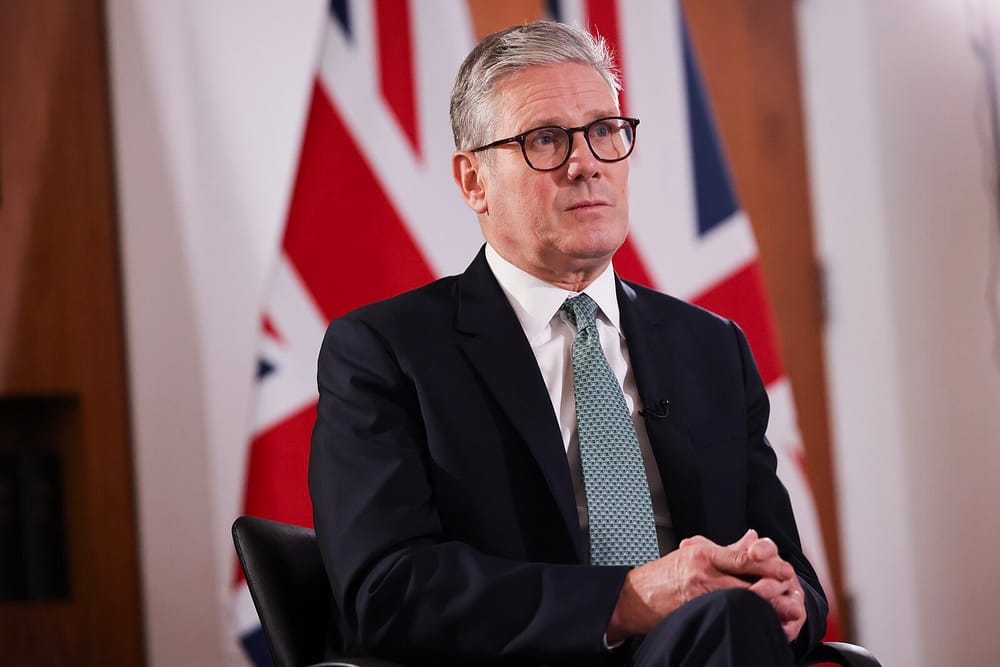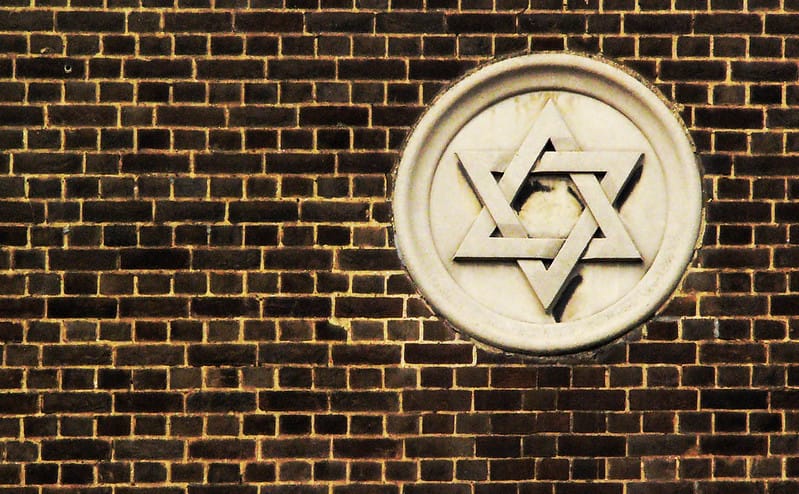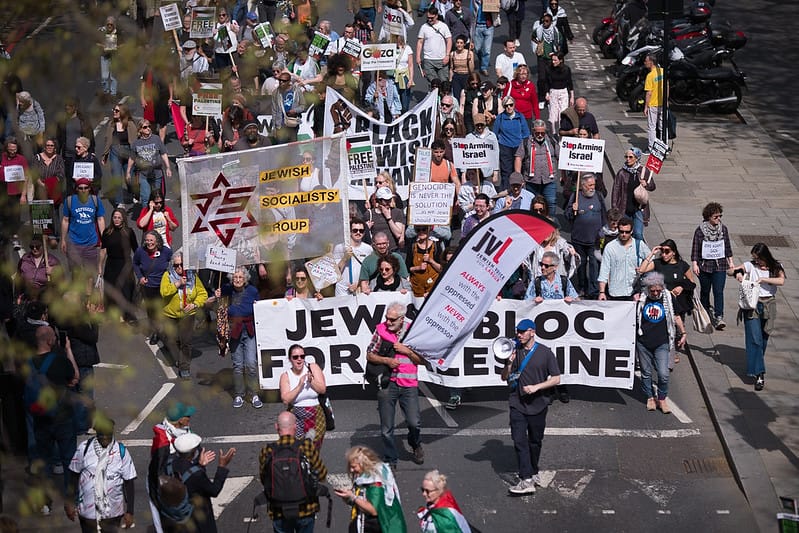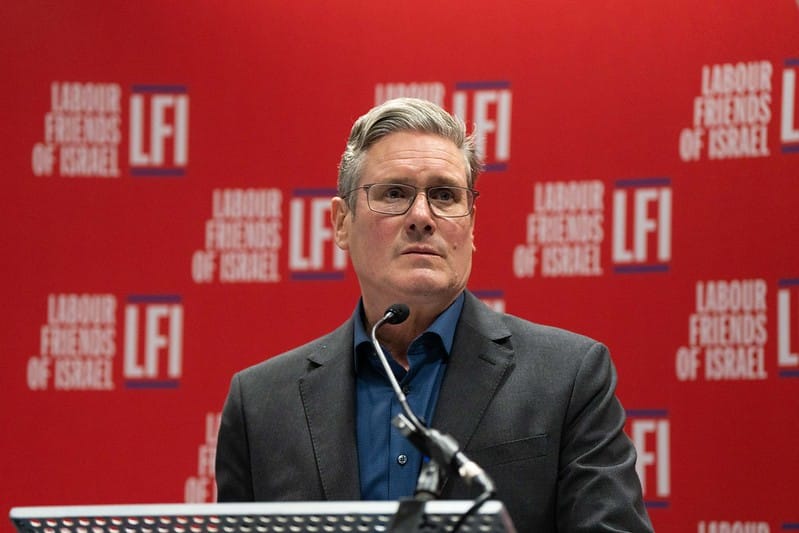A long way from Cable Street
Last weekend’s March Against Antisemitism was in fact a march against solidarity with Palestinians.

Following last Sunday’s “March Against Antisemitism”, the demonstration’s organisers, the Campaign Against Antisemitism (CAA), announced triumphantly: “Britain has not seen a gathering against antisemitism of this size in almost a century, since the Battle of Cable Street. We are proud to come together to say: This is the United Kingdom: United Against Antisemitism.” Yet the CAA’s claim of affinity between Sunday’s march and the Battle of Cable Street is both strange and historically misleading.
The CAA was formed in 2014, after a previous Israeli bombardment of Gaza. Its explicit founding purpose was to counter the antisemitism that arises in Britain when Israel pummels Palestinians and, implicitly, to defend Israel’s right to pummel. Chief executive Gideon Falter is also vice chairman of the Jewish National Fund (JNF) UK, which is reported to have provided funding to the CAA in the past. The JNF enjoys charitable status and its existence predates the Balfour Declaration. For over a century, it has bought up land in historic Palestine, helped plan the Nakba, furthered exclusive Jewish settlement and transformed colonised land into parks and forests to erase what had been before.
The history of a faulty comparison
In contrast to the institutional support for Sunday’s march, the Battle of Cable Street was fought from below. In 1936, the Jewish communal leadership with which the CAA today are so often in lockstep – the Board of Deputies, the Jewish Chronicle – told Jews to stay home. They weren’t alone. The Labour Party, the Liberals, the Tory government, national newspapers, even, at first, the Communist Party leadership, told Jews and others not to confront the fascists.
As police and fascist violence against East End Jews ramped up in the 1930s, Jewish workers, Communists and others developed a physical force antifascism to counter the violence of Sir Oswald Mosley’s Blackshirts – to not let them speak on street corners, sell their newspapers or hold rallies in London’s largest arenas.
The reason why the comparison between 1936 and today is so incongruous isn’t just the different class composition of the marches or the role of leaders, but also how participants understood racism and fascism. Jewish elites in the 1930s saw antisemitism as un-British. They tried to out-British the fascists or to “factcheck” them into submission. The Jewish Chronicle, reluctant for years to call Mosley an antisemite because of his aristocratic breeding, clung to the delusion that “on reflection we are sure Sir Oswald will see the illogicality of his attitude.”
The integrationist respectability politics of communal and religious leaders was rooted in a belief that antisemitism was formally ended by a 19th century “emancipation” that lifted restrictions on Jews from universities, professions and parliament. Elite Jews often blamed poor, immigrant and leftist Jews for the oppression they faced. Their strategy was a meek appeal to middle England and the benevolence of the authorities. When Mosley threatened to march through the Jewish East End in October 1936, the community knew that it would not have the backing of its traditional leaders.
Sunday’s organisers, supporters and marchers continue to use their proximity to the state to contrast their so-called “orderliness” with their perceptions of recent Palestine solidarity marches. After all, the March Against Antisemitism was a reaction against these marches. The CAA state that they called the march because “week after week, London has become a no-go zone for Jews.” They also reveal that they called on police to ban the Palestine marches for their “hatred”, “glorification of terrorism” and “criminality”. Many spokespeople and interviewees have emphasised support from the government and opposition as well as friendly relations with the police, a stark contrast to the Jews fighting racism and fascism in Britain, both at Cable Street and for most of our history in this country.
This is also starkly different from the hostility and racism Palestine solidarity marches have received from politicians and media. Compared to the “foreign”, “threatening” and “terroristic” Palestine marches, the March Against Antisemitism was remarked upon for the Britishness of the occasion and of the values on show. Union Jacks and Israeli flags were prominent as a stirring rendition of God Save The King rang out at Whitehall.
The CAA announced the kind of supporters they sought and the politics they stood for: “Among those friends backing the march are the stalwart allies of the Jewish community behind the October Declaration. We are proud to have friends like these, who are not afraid to call out antisemitism, speak up for the truth and love our country.” The October Declaration is signed by every journalist, politician, Lord and OBE that pollutes public life with racism, transphobia and misogyny.
The philosemitic embrace
The philosemitic identification of the CAA’s “friends”’ is part of a longer-term history of Jews in Europe. For over half a century, western liberalism has celebrated its virtues through ceremonialised denunciations of a Holocaust born of European civilisation. It retroactively makes that civilisation “Judeo-Christian” to obscure the threads linking the Shoah and long histories of antisemitism to the centuries of colonialism, slavery and genocides that enriched the West and continue to shape power and racism globally today.
Philosemitism ensures that Jews are homogenised, racialised in a way that suits the interests of white supremacy and Zionism, allowing gentile national cultures to claim Jewish history and suffering as their own. As Houria Bouteldja puts it: “[they] made you into the most passionate defenders of the empire on Arab soil. What they did was even more vicious. They managed to make you trade your religion, your history, and your memories for a colonial ideology.”
Holocaust memory culture allows Britain to displace its own racism and to burnish its postwar national identity through constant monitoring, bordering and violence towards its racialised citizens and migrants. Increasingly, British politicians and public figures do so on the premise that they are defending Jews. Enzo Traverso writes: “Institutionalized and neutralized, the memory of the Holocaust thus risks becoming the moral sanction for a Western order that perpetuates oppression and injustice.” This is no longer a risk. This time is upon us.
The “antiracism” of the March Against Antisemitism is one of accepting the role of “state-protected race”. It is one of working closely with the government and the criminal justice system, of thinking “hate crime” legislation does away with racism. The most visibly Jewish people in Britain, those most exposed to antisemitic violence, won’t be protected by this form of antiracism – the kind espoused by Jewish elites who condemned the Jews who stood against Mosley. Board of Deputies president Neville Laski welcomed the new Public Order Act in 1936. The law promised to curtail the marching and uniform-wearing of the Blackshirts. It was, of course, used far more against antifascists, as has been the case with updated versions of the law.
Many Jews may well be afraid – a very real rise in antisemitism gives us some reason to be – but this was not a march against antisemitism. Not for those who organised it, nor for most gentiles supporting it. It was a march against solidarity with Palestinians. A march to maintain Zionist colonialism and Palestinian unfreedom, while a genocide proceeds against an imprisoned population. A march to affirm the philosemitic embrace of the figure of The Jew in Britain – an embrace that makes Jews a bulwark against other antiracist struggles and human shields for Euro-American racial capitalism.
Towards a decolonial and antiracist Judaism
Antisemitism is dangerous and it is adaptable. It is always “available” and anyone can draw on it. It is, as Adorno said, “the rumour about the Jews”. The rumour keeps spreading and increasingly it interacts with Israel’s oppression of Palestinians. But it is impossible to unite against antisemitism if you disagree on what it is, what causes it, where it comes from and how you fight it.
We Jews are divided, as all racialised groups are divided. Stratification along lines of class, ethnic difference, gender, and political ideology are mundane facts. But we are also divided because of a colonial project done in our name. The state of Israel’s existence as a Jewish state, whose association with world Jewry is made constantly inextricable by Zionists – Jewish and non-Jewish – marks a fundamental breach between those who want Jews and everyone to live free from oppression and violence, and those who prioritise a settler-colonial citadel and its ineluctable alliances with imperialists and fascists the world over.
Zionism was rejected by most diaspora Jews until European antisemitism tried to annihilate us. No matter how much Zionists try to paint Palestinians as the new Nazis, or worse than Nazis, it was Europe’s fault that so many Jews became settlers on Palestinian land. Europe’s antisemitism drove the Jewish embrace of Zionism. The European Jews in the metropole who drove Zionism bought into bourgeois nationalism, racism and colonialism. These European logics, alliances and accumulations bolstered early Zionists as they scoured the globe for a colonial plot to plant their flag.
The organisation founded to lead the antifascists of the East End was the Jewish People’s Council Against Fascism and Antisemitism. When the dust settled after Cable Street, they released a statement about the Board of Deputies, whose legitimacy they had challenged:
“On October 4th Mosley challenged Jewry, announcing his intentions to march uniformed columns through the Jewish quarters of Stepney … The Board [of Deputies] instead of meeting this challenge, retreated from it! The Board argues that to expose the lies and defamation is sufficient to safeguard Jewry. Antisemitism is a part of fascism. Only the defeat of fascism will remove organised antisemitism. Can the Jews alone defeat fascism, the breeder of antisemitism? No! Jewry alone cannot … Who are our possible allies? Only the democratic forces also threatened by fascism. Can we say to them ‘Help us in our fight against antisemitism, but we will not fight with you against fascism?'”
These words should echo in the ears of Jews today. But our “allies” must not only be those “threatened by fascism” but those oppressed and exploited through racism and colonialism globally. Jewish Voice For Peace, If Not Now and other radical Jews in the US have led the way. The multiracial, multigenerational Jewish Bloc that has grown with each Palestine march and sit-in in London are welcomed with open arms.
This demonstrates true solidarity – putting one’s body on the line for another. It demonstrates a knowledge that our own freedom is indelibly tied to the freedom of other oppressed people, particularly those oppressed “in our name”. This fight requires a struggle within the category of Jewishness, one that prioritises the freedom of Palestinians as a means of also freeing Jews.
Patrick Wolfe wrote that “race is colonialism speaking”. The struggle against racism isn’t a fight for state patronage, “hate crime” laws or police protection. It is a global struggle to overturn the colonial order that produced “race” in the first place. Nothing short of a decolonial and antiracist Judaism is what is required. To take our place proudly within the huge antiracist movements required to meet this time of fascism.
Michael Richmond is the co-author, with Alex Charnley, of the book Fractured: Race, Class, Gender and the Hatred of Identity Politics, out now with Pluto Press. They are currently working on their second book together.
Author

Michael Richmond is the co-author, with Alex Charnley, of the book Fractured: Race, Class, Gender and the Hatred of Identity Politics, out now with Pluto Press.
Sign up for The Pickle and New, From Vashti.
Stay up to date with Vashti.



